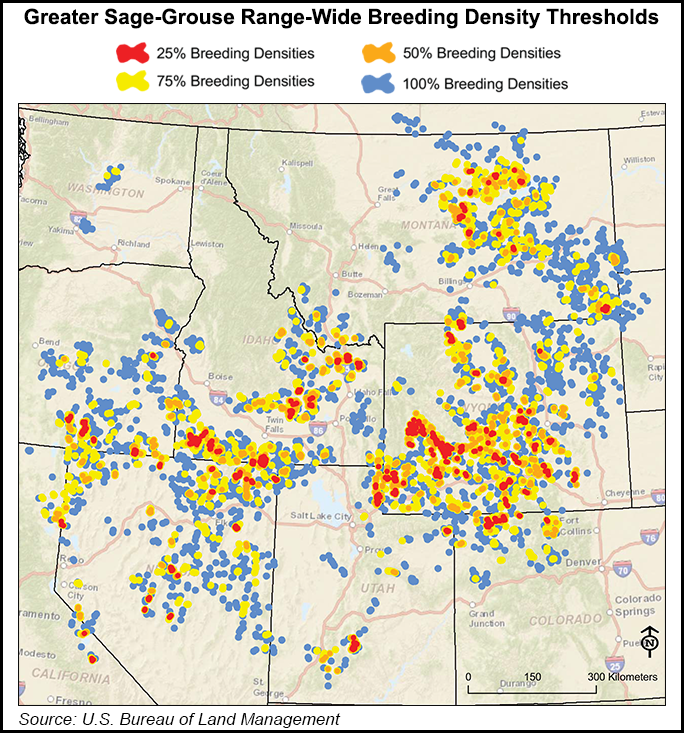Regulatory | NGI All News Access | NGI The Weekly Gas Market Report
BLM Opens Wyoming Drilling Review Amid Sage Grouse Concerns
The federal Bureau of Land Management (BLM) has begun the environmental review process for a major proposed multi-year oil/natural gas drilling project in east-central Wyoming that could force federal authorities to adjust their current species and habitat protection requirements. BLM is taking comments through June 30.

BLM on Thursday published a notice of intent to prepare a draft environmental impact statement (EIS) on a proposal from five exploration and production (E&P) companies to drill up to 5,000 oil/gas wells during a 10-year period. BLM would serve as the lead agency along with the U.S. Forest Service’s (USFS) Douglas Ranger District.
The alert in the Federal Register acknowledged that the extensive plans by a combination of units of Anadarko Petroleum Corp., Chesapeake Energy Corp., RKI E&P LLC, Samson Resources and SM Energy may require amendments to the BLM’s Casper Resource Management Plan and the USFS’ Thunder Basin National Grasslands Land and Resource Management Plan.
BLM said that “impacts are expected to exceed analysis thresholds set within the current planning documents.”
Although there is no specific mention of a sage grouse protection plan in either the proposals set forth by the BLM or by the companies, at least one sage grouse activist in the state has raised concerns, according to environmental observers following the proposed project and federal response.
According to BLM, the proposed drilling project encompasses about 88,000 surface acres (6% of the project area) and 965,000 subsurface mineral acres (64% if the overall project area) of public lands overseen by the agency. The rest of the project area consists of Wyoming state or private surface and mineral ownership, the EIS said.
Of the 1.5 million acres in the proposed project, 964,525 acres are federal mineral estate lands and 537,182 acres are non-federal mineral estate properties, according to the project filing to BLM from the five E&Ps. “The project is located entirely within the boundaries of Converse County,” the project filing said.
Drilling and completion pads are expected to vary in size up to 12 acres, and the numbers of wells drilled on each pad could vary from one to 16, according to the companies. They said they are seeking authority to conduct drilling operations on a year-round basis for the 10-year period.
Environmental sector observers see the BLM’s landscape-scale mitigation approaches as being thrust into a test case with the Converse County project — which needs to avoid and minimize adverse impacts to species and habitats for the sage grouse and others — but also to compensate in other geographical areas for unavoidable impacts in the project areas.
One wildlife biologist with WildEarth Guardians already has raised concerns about the “link being broken” in Wyoming between sage grouse populations in Montana and the Dakotas. Production equipment, particularly for oil, is viewed by environmental advocates as disruptive to ground-dwelling bird populations.
Last year, Chesapeake and the Wyoming Wildlife Natural Resource Trust (WNRT) worked on a plan that would regulate drilling oil wells in an area of that state designated as sage grouse habitat. WNRT and Chesapeake officials discussed the proposed drilling plan. The deal would divide the Douglas Core Area into three zones, with Chesapeake suspending drilling in one zone and the state allowing some drilling in the other two zones, according to media reports (see Daily GPI, Sept. 20, 2013).
Three years ago, the U.S. Fish and Wildlife Service sent Wyoming Gov. Matt Mead a letter of commendation for the state’s efforts to conserve the sage grouse throughout the state under a protection plan ordered by the governor (see Daily GPI, July 1, 2011).
© 2024 Natural Gas Intelligence. All rights reserved.
ISSN © 1532-1231 | ISSN © 2577-9877 | ISSN © 1532-1266 |
